Patient Care: Transtheoretical Model and Motivational Interviewing
VerifiedAdded on 2023/06/04
|6
|1593
|226
Essay
AI Summary
This essay discusses the application of the Transtheoretical Model of Change and Motivational Interviewing techniques in managing a 55-year-old overweight patient, Alistair, undergoing total knee management. It highlights the role of a nursing team in guiding the patient through the stages of change, from precontemplation to maintenance, using strategies like consciousness-raising and stimulus control. The essay also emphasizes the importance of gathering information, educating the patient about health risks, and instilling hope. Furthermore, it addresses the need to explore lifestyle choices, assess commitment to change, and implement coping strategies to prevent relapse, ultimately aiming to improve the patient's health outcomes. Desklib provides similar solved assignments for students.
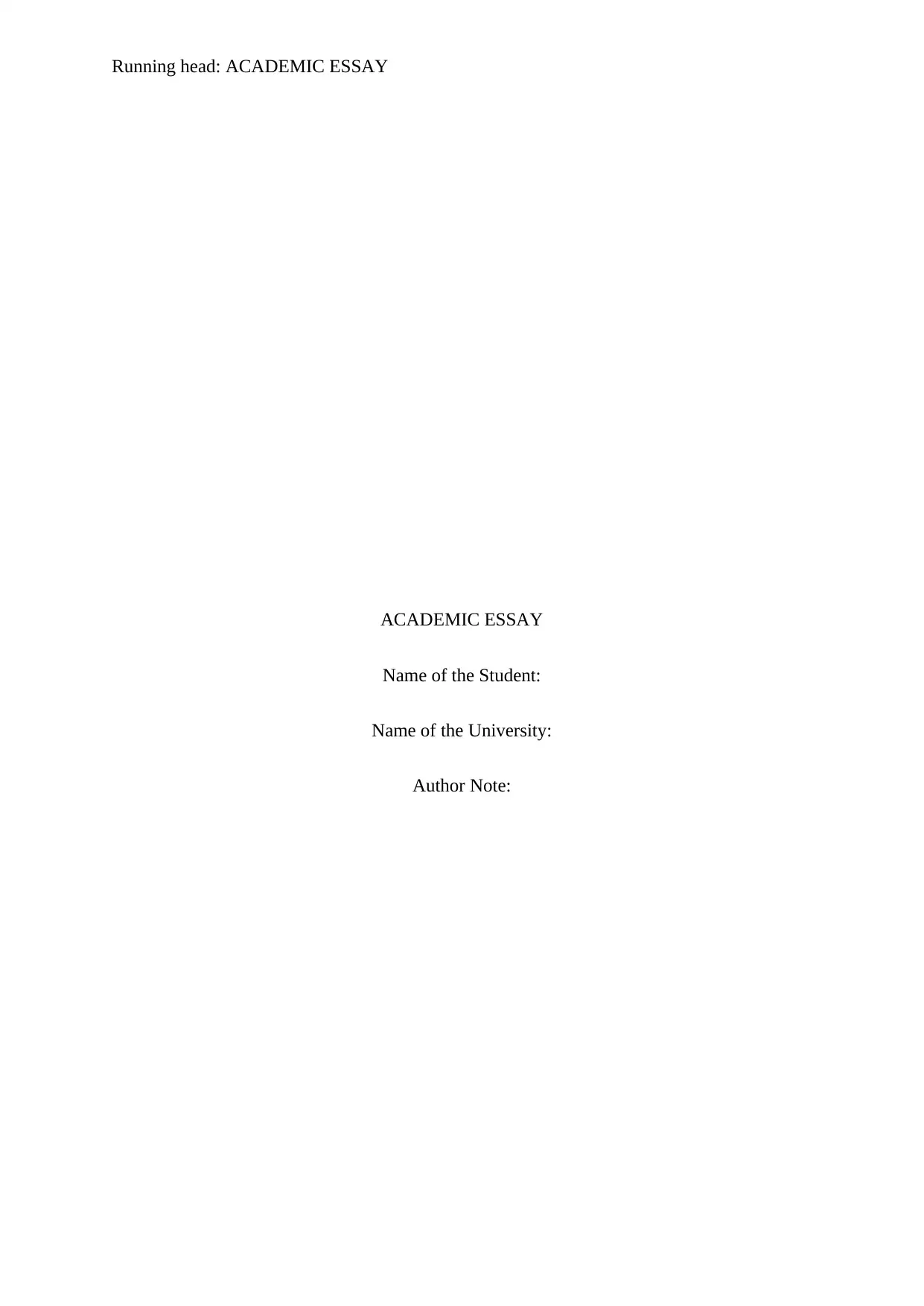
Running head: ACADEMIC ESSAY
ACADEMIC ESSAY
Name of the Student:
Name of the University:
Author Note:
ACADEMIC ESSAY
Name of the Student:
Name of the University:
Author Note:
Paraphrase This Document
Need a fresh take? Get an instant paraphrase of this document with our AI Paraphraser
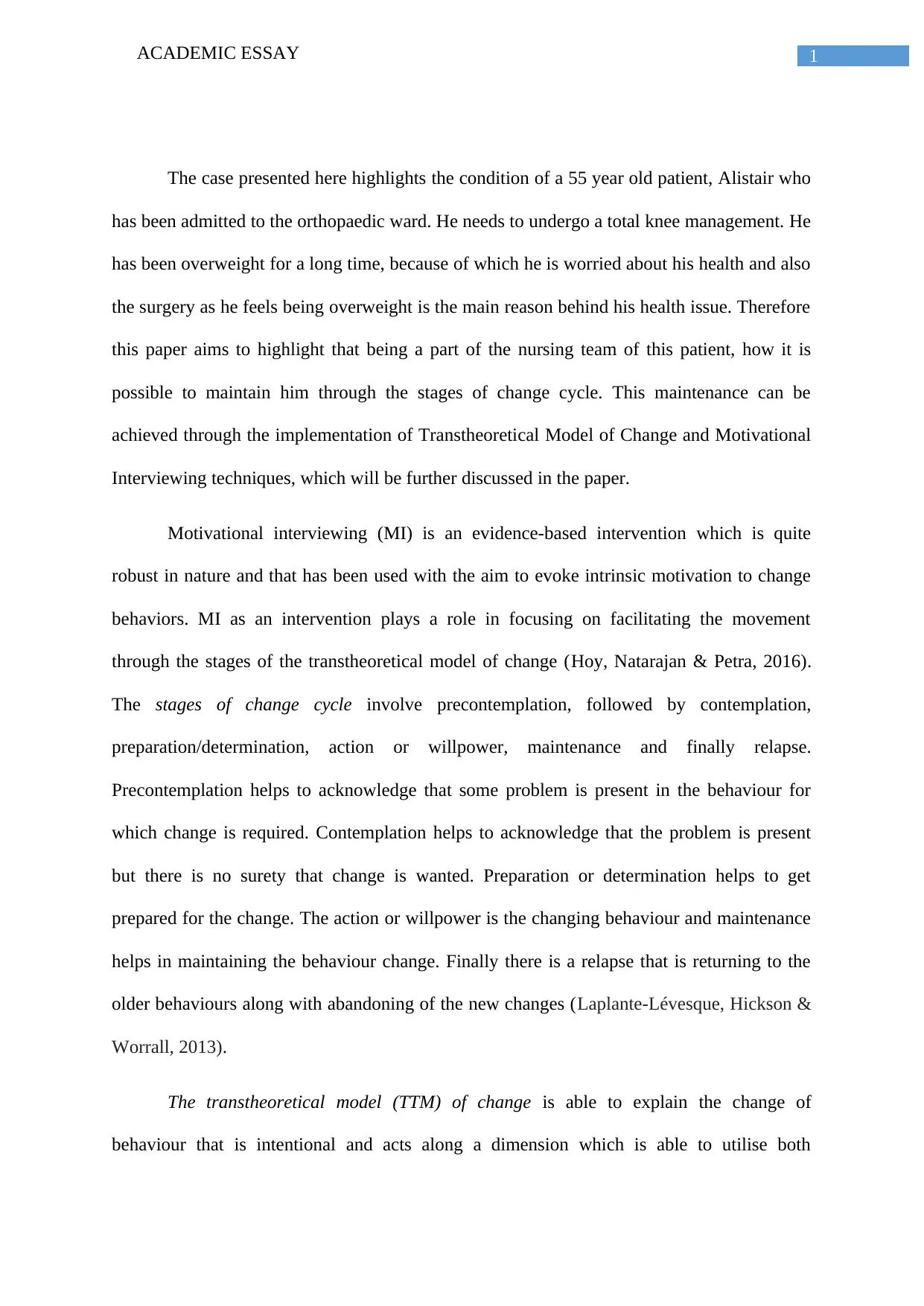
1ACADEMIC ESSAY
The case presented here highlights the condition of a 55 year old patient, Alistair who
has been admitted to the orthopaedic ward. He needs to undergo a total knee management. He
has been overweight for a long time, because of which he is worried about his health and also
the surgery as he feels being overweight is the main reason behind his health issue. Therefore
this paper aims to highlight that being a part of the nursing team of this patient, how it is
possible to maintain him through the stages of change cycle. This maintenance can be
achieved through the implementation of Transtheoretical Model of Change and Motivational
Interviewing techniques, which will be further discussed in the paper.
Motivational interviewing (MI) is an evidence-based intervention which is quite
robust in nature and that has been used with the aim to evoke intrinsic motivation to change
behaviors. MI as an intervention plays a role in focusing on facilitating the movement
through the stages of the transtheoretical model of change (Hoy, Natarajan & Petra, 2016).
The stages of change cycle involve precontemplation, followed by contemplation,
preparation/determination, action or willpower, maintenance and finally relapse.
Precontemplation helps to acknowledge that some problem is present in the behaviour for
which change is required. Contemplation helps to acknowledge that the problem is present
but there is no surety that change is wanted. Preparation or determination helps to get
prepared for the change. The action or willpower is the changing behaviour and maintenance
helps in maintaining the behaviour change. Finally there is a relapse that is returning to the
older behaviours along with abandoning of the new changes (Laplante-Lévesque, Hickson &
Worrall, 2013).
The transtheoretical model (TTM) of change is able to explain the change of
behaviour that is intentional and acts along a dimension which is able to utilise both
The case presented here highlights the condition of a 55 year old patient, Alistair who
has been admitted to the orthopaedic ward. He needs to undergo a total knee management. He
has been overweight for a long time, because of which he is worried about his health and also
the surgery as he feels being overweight is the main reason behind his health issue. Therefore
this paper aims to highlight that being a part of the nursing team of this patient, how it is
possible to maintain him through the stages of change cycle. This maintenance can be
achieved through the implementation of Transtheoretical Model of Change and Motivational
Interviewing techniques, which will be further discussed in the paper.
Motivational interviewing (MI) is an evidence-based intervention which is quite
robust in nature and that has been used with the aim to evoke intrinsic motivation to change
behaviors. MI as an intervention plays a role in focusing on facilitating the movement
through the stages of the transtheoretical model of change (Hoy, Natarajan & Petra, 2016).
The stages of change cycle involve precontemplation, followed by contemplation,
preparation/determination, action or willpower, maintenance and finally relapse.
Precontemplation helps to acknowledge that some problem is present in the behaviour for
which change is required. Contemplation helps to acknowledge that the problem is present
but there is no surety that change is wanted. Preparation or determination helps to get
prepared for the change. The action or willpower is the changing behaviour and maintenance
helps in maintaining the behaviour change. Finally there is a relapse that is returning to the
older behaviours along with abandoning of the new changes (Laplante-Lévesque, Hickson &
Worrall, 2013).
The transtheoretical model (TTM) of change is able to explain the change of
behaviour that is intentional and acts along a dimension which is able to utilise both
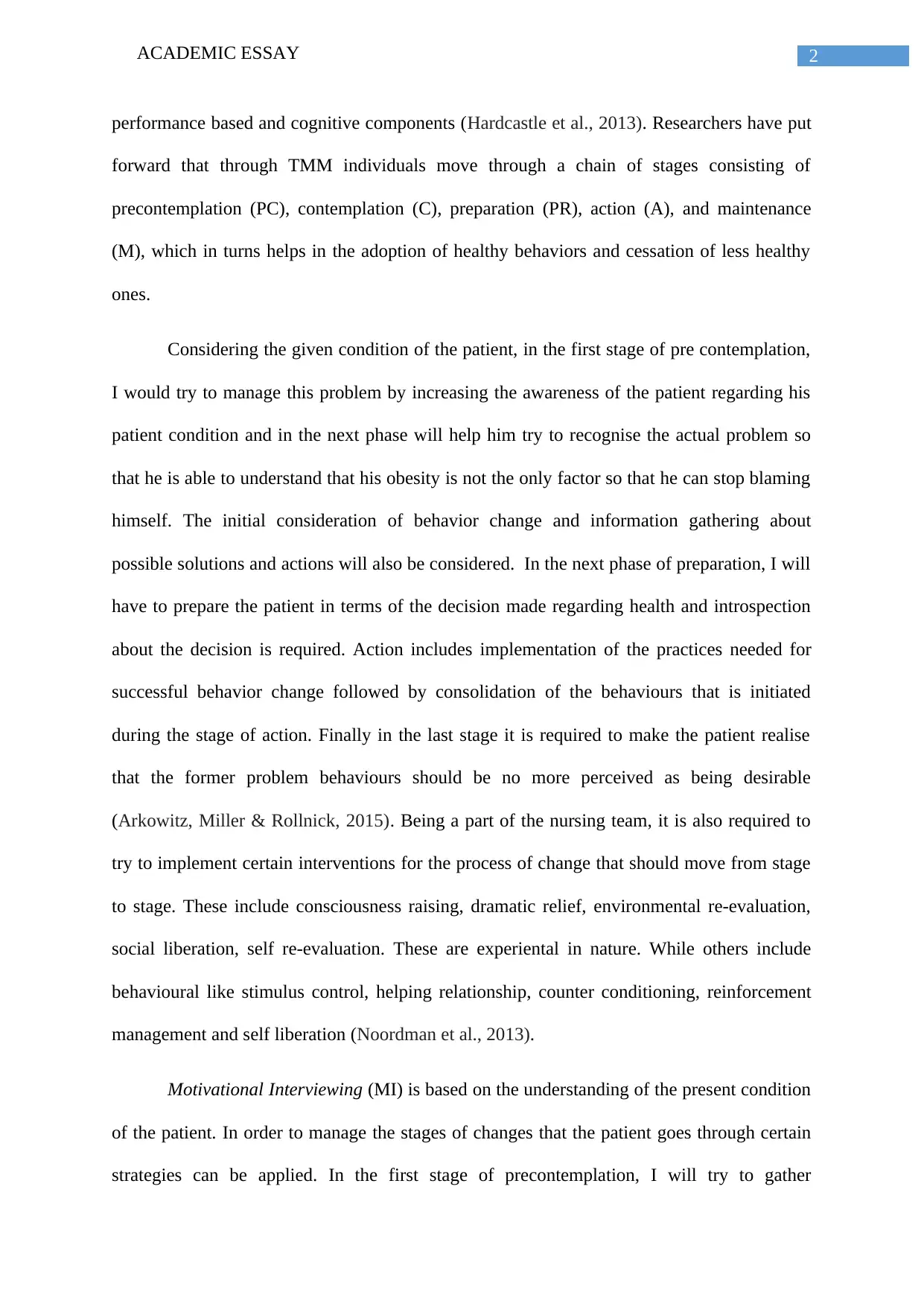
2ACADEMIC ESSAY
performance based and cognitive components (Hardcastle et al., 2013). Researchers have put
forward that through TMM individuals move through a chain of stages consisting of
precontemplation (PC), contemplation (C), preparation (PR), action (A), and maintenance
(M), which in turns helps in the adoption of healthy behaviors and cessation of less healthy
ones.
Considering the given condition of the patient, in the first stage of pre contemplation,
I would try to manage this problem by increasing the awareness of the patient regarding his
patient condition and in the next phase will help him try to recognise the actual problem so
that he is able to understand that his obesity is not the only factor so that he can stop blaming
himself. The initial consideration of behavior change and information gathering about
possible solutions and actions will also be considered. In the next phase of preparation, I will
have to prepare the patient in terms of the decision made regarding health and introspection
about the decision is required. Action includes implementation of the practices needed for
successful behavior change followed by consolidation of the behaviours that is initiated
during the stage of action. Finally in the last stage it is required to make the patient realise
that the former problem behaviours should be no more perceived as being desirable
(Arkowitz, Miller & Rollnick, 2015). Being a part of the nursing team, it is also required to
try to implement certain interventions for the process of change that should move from stage
to stage. These include consciousness raising, dramatic relief, environmental re-evaluation,
social liberation, self re-evaluation. These are experiental in nature. While others include
behavioural like stimulus control, helping relationship, counter conditioning, reinforcement
management and self liberation (Noordman et al., 2013).
Motivational Interviewing (MI) is based on the understanding of the present condition
of the patient. In order to manage the stages of changes that the patient goes through certain
strategies can be applied. In the first stage of precontemplation, I will try to gather
performance based and cognitive components (Hardcastle et al., 2013). Researchers have put
forward that through TMM individuals move through a chain of stages consisting of
precontemplation (PC), contemplation (C), preparation (PR), action (A), and maintenance
(M), which in turns helps in the adoption of healthy behaviors and cessation of less healthy
ones.
Considering the given condition of the patient, in the first stage of pre contemplation,
I would try to manage this problem by increasing the awareness of the patient regarding his
patient condition and in the next phase will help him try to recognise the actual problem so
that he is able to understand that his obesity is not the only factor so that he can stop blaming
himself. The initial consideration of behavior change and information gathering about
possible solutions and actions will also be considered. In the next phase of preparation, I will
have to prepare the patient in terms of the decision made regarding health and introspection
about the decision is required. Action includes implementation of the practices needed for
successful behavior change followed by consolidation of the behaviours that is initiated
during the stage of action. Finally in the last stage it is required to make the patient realise
that the former problem behaviours should be no more perceived as being desirable
(Arkowitz, Miller & Rollnick, 2015). Being a part of the nursing team, it is also required to
try to implement certain interventions for the process of change that should move from stage
to stage. These include consciousness raising, dramatic relief, environmental re-evaluation,
social liberation, self re-evaluation. These are experiental in nature. While others include
behavioural like stimulus control, helping relationship, counter conditioning, reinforcement
management and self liberation (Noordman et al., 2013).
Motivational Interviewing (MI) is based on the understanding of the present condition
of the patient. In order to manage the stages of changes that the patient goes through certain
strategies can be applied. In the first stage of precontemplation, I will try to gather
⊘ This is a preview!⊘
Do you want full access?
Subscribe today to unlock all pages.

Trusted by 1+ million students worldwide
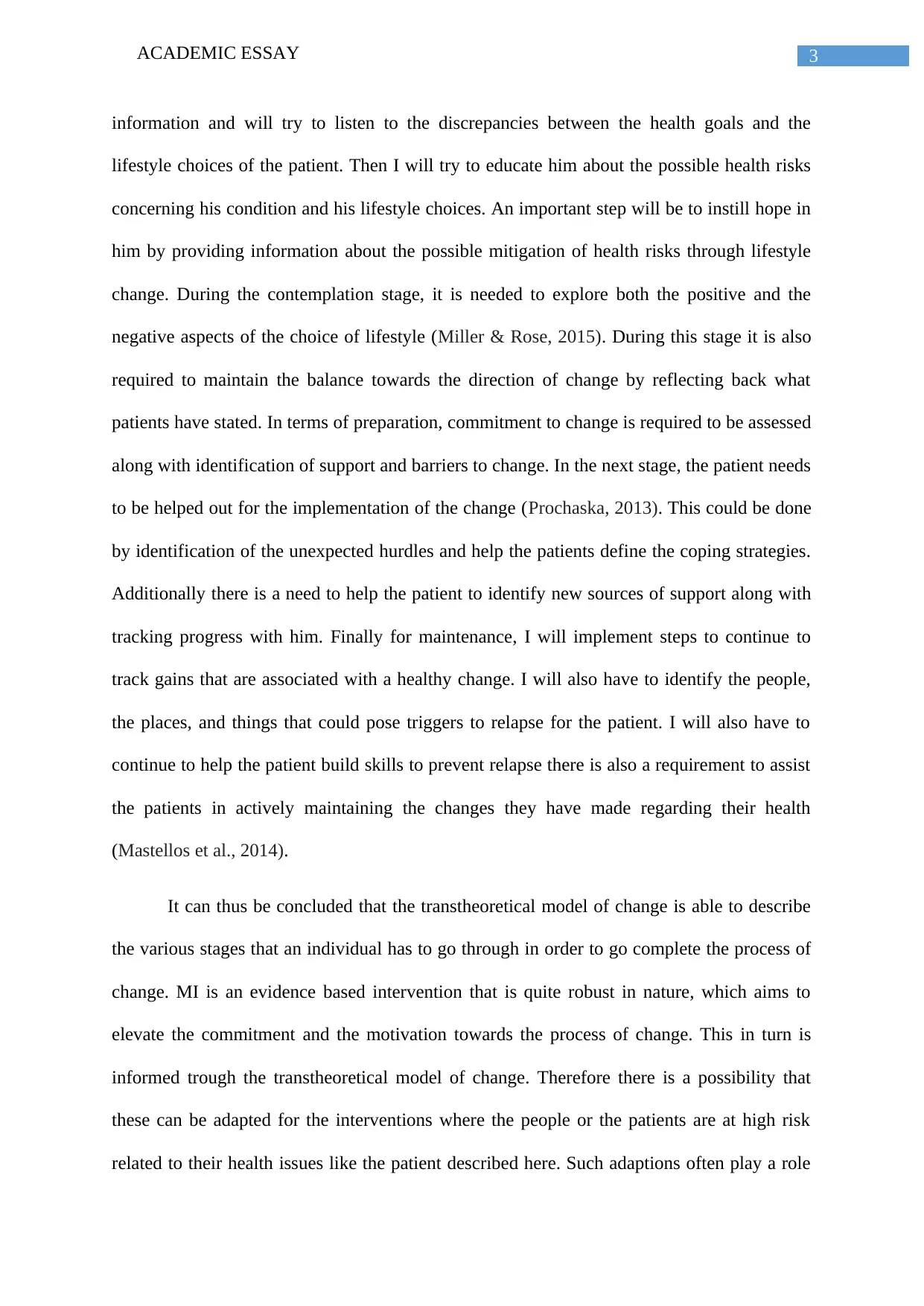
3ACADEMIC ESSAY
information and will try to listen to the discrepancies between the health goals and the
lifestyle choices of the patient. Then I will try to educate him about the possible health risks
concerning his condition and his lifestyle choices. An important step will be to instill hope in
him by providing information about the possible mitigation of health risks through lifestyle
change. During the contemplation stage, it is needed to explore both the positive and the
negative aspects of the choice of lifestyle (Miller & Rose, 2015). During this stage it is also
required to maintain the balance towards the direction of change by reflecting back what
patients have stated. In terms of preparation, commitment to change is required to be assessed
along with identification of support and barriers to change. In the next stage, the patient needs
to be helped out for the implementation of the change (Prochaska, 2013). This could be done
by identification of the unexpected hurdles and help the patients define the coping strategies.
Additionally there is a need to help the patient to identify new sources of support along with
tracking progress with him. Finally for maintenance, I will implement steps to continue to
track gains that are associated with a healthy change. I will also have to identify the people,
the places, and things that could pose triggers to relapse for the patient. I will also have to
continue to help the patient build skills to prevent relapse there is also a requirement to assist
the patients in actively maintaining the changes they have made regarding their health
(Mastellos et al., 2014).
It can thus be concluded that the transtheoretical model of change is able to describe
the various stages that an individual has to go through in order to go complete the process of
change. MI is an evidence based intervention that is quite robust in nature, which aims to
elevate the commitment and the motivation towards the process of change. This in turn is
informed trough the transtheoretical model of change. Therefore there is a possibility that
these can be adapted for the interventions where the people or the patients are at high risk
related to their health issues like the patient described here. Such adaptions often play a role
information and will try to listen to the discrepancies between the health goals and the
lifestyle choices of the patient. Then I will try to educate him about the possible health risks
concerning his condition and his lifestyle choices. An important step will be to instill hope in
him by providing information about the possible mitigation of health risks through lifestyle
change. During the contemplation stage, it is needed to explore both the positive and the
negative aspects of the choice of lifestyle (Miller & Rose, 2015). During this stage it is also
required to maintain the balance towards the direction of change by reflecting back what
patients have stated. In terms of preparation, commitment to change is required to be assessed
along with identification of support and barriers to change. In the next stage, the patient needs
to be helped out for the implementation of the change (Prochaska, 2013). This could be done
by identification of the unexpected hurdles and help the patients define the coping strategies.
Additionally there is a need to help the patient to identify new sources of support along with
tracking progress with him. Finally for maintenance, I will implement steps to continue to
track gains that are associated with a healthy change. I will also have to identify the people,
the places, and things that could pose triggers to relapse for the patient. I will also have to
continue to help the patient build skills to prevent relapse there is also a requirement to assist
the patients in actively maintaining the changes they have made regarding their health
(Mastellos et al., 2014).
It can thus be concluded that the transtheoretical model of change is able to describe
the various stages that an individual has to go through in order to go complete the process of
change. MI is an evidence based intervention that is quite robust in nature, which aims to
elevate the commitment and the motivation towards the process of change. This in turn is
informed trough the transtheoretical model of change. Therefore there is a possibility that
these can be adapted for the interventions where the people or the patients are at high risk
related to their health issues like the patient described here. Such adaptions often play a role
Paraphrase This Document
Need a fresh take? Get an instant paraphrase of this document with our AI Paraphraser
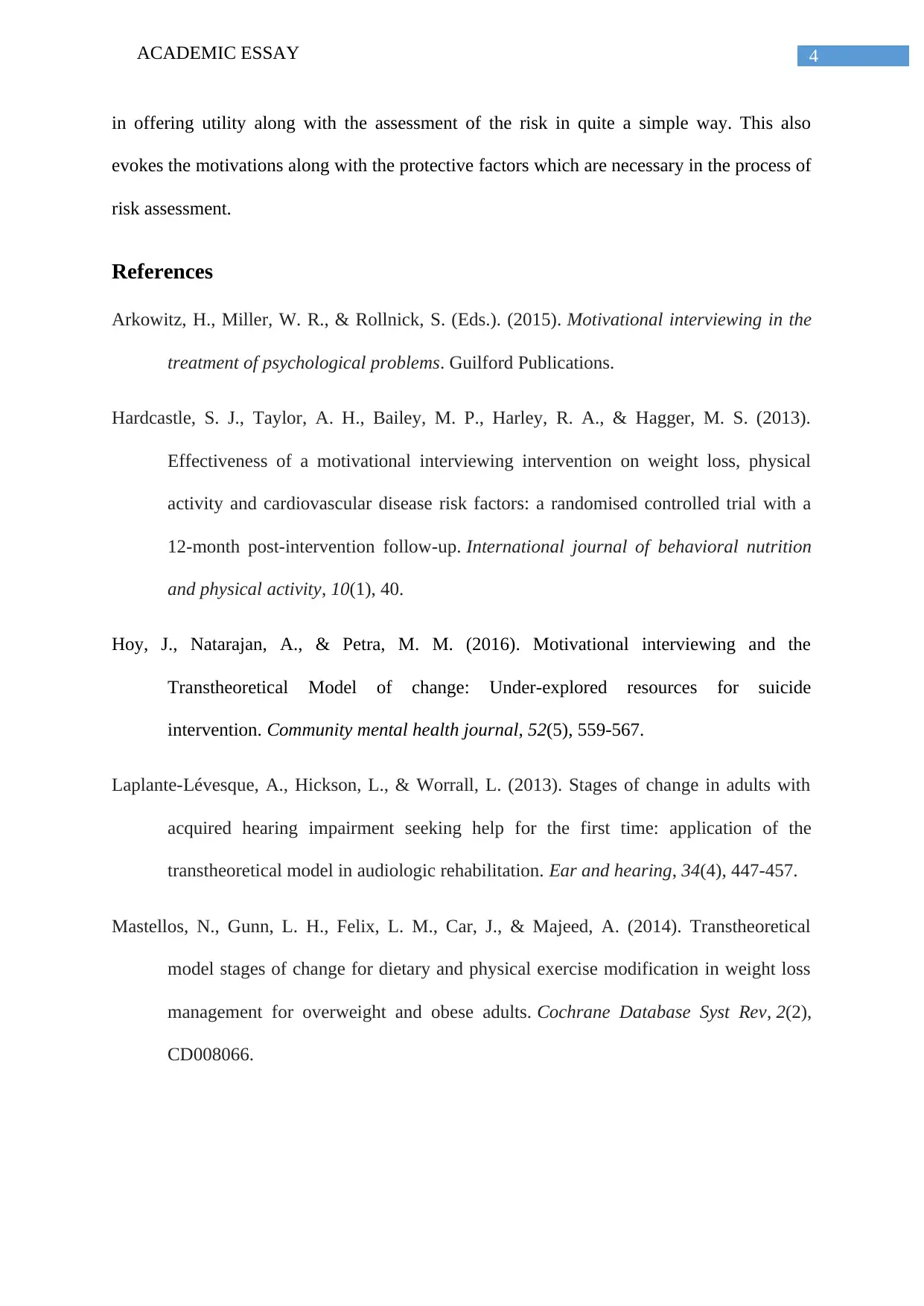
4ACADEMIC ESSAY
in offering utility along with the assessment of the risk in quite a simple way. This also
evokes the motivations along with the protective factors which are necessary in the process of
risk assessment.
References
Arkowitz, H., Miller, W. R., & Rollnick, S. (Eds.). (2015). Motivational interviewing in the
treatment of psychological problems. Guilford Publications.
Hardcastle, S. J., Taylor, A. H., Bailey, M. P., Harley, R. A., & Hagger, M. S. (2013).
Effectiveness of a motivational interviewing intervention on weight loss, physical
activity and cardiovascular disease risk factors: a randomised controlled trial with a
12-month post-intervention follow-up. International journal of behavioral nutrition
and physical activity, 10(1), 40.
Hoy, J., Natarajan, A., & Petra, M. M. (2016). Motivational interviewing and the
Transtheoretical Model of change: Under-explored resources for suicide
intervention. Community mental health journal, 52(5), 559-567.
Laplante-Lévesque, A., Hickson, L., & Worrall, L. (2013). Stages of change in adults with
acquired hearing impairment seeking help for the first time: application of the
transtheoretical model in audiologic rehabilitation. Ear and hearing, 34(4), 447-457.
Mastellos, N., Gunn, L. H., Felix, L. M., Car, J., & Majeed, A. (2014). Transtheoretical
model stages of change for dietary and physical exercise modification in weight loss
management for overweight and obese adults. Cochrane Database Syst Rev, 2(2),
CD008066.
in offering utility along with the assessment of the risk in quite a simple way. This also
evokes the motivations along with the protective factors which are necessary in the process of
risk assessment.
References
Arkowitz, H., Miller, W. R., & Rollnick, S. (Eds.). (2015). Motivational interviewing in the
treatment of psychological problems. Guilford Publications.
Hardcastle, S. J., Taylor, A. H., Bailey, M. P., Harley, R. A., & Hagger, M. S. (2013).
Effectiveness of a motivational interviewing intervention on weight loss, physical
activity and cardiovascular disease risk factors: a randomised controlled trial with a
12-month post-intervention follow-up. International journal of behavioral nutrition
and physical activity, 10(1), 40.
Hoy, J., Natarajan, A., & Petra, M. M. (2016). Motivational interviewing and the
Transtheoretical Model of change: Under-explored resources for suicide
intervention. Community mental health journal, 52(5), 559-567.
Laplante-Lévesque, A., Hickson, L., & Worrall, L. (2013). Stages of change in adults with
acquired hearing impairment seeking help for the first time: application of the
transtheoretical model in audiologic rehabilitation. Ear and hearing, 34(4), 447-457.
Mastellos, N., Gunn, L. H., Felix, L. M., Car, J., & Majeed, A. (2014). Transtheoretical
model stages of change for dietary and physical exercise modification in weight loss
management for overweight and obese adults. Cochrane Database Syst Rev, 2(2),
CD008066.
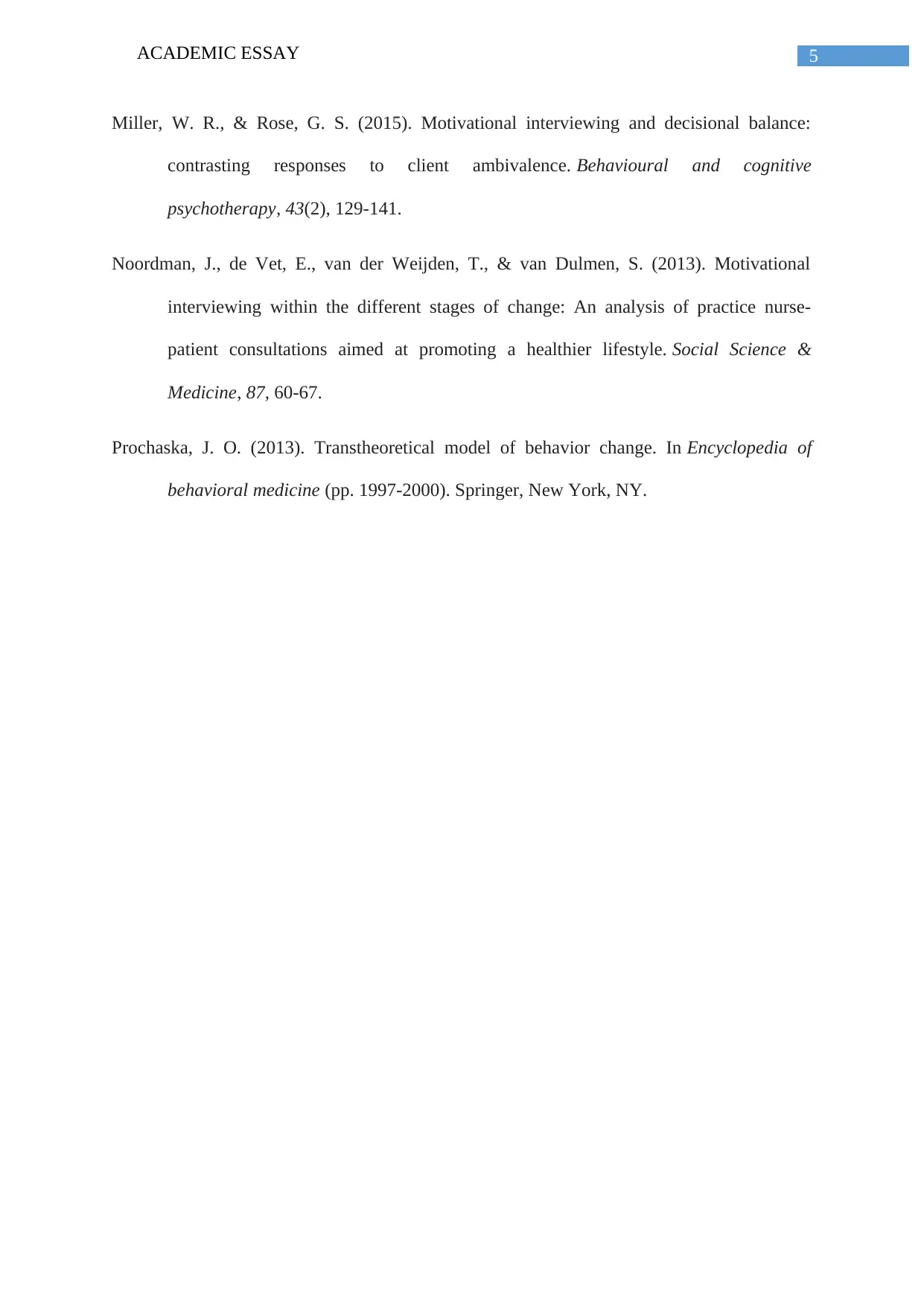
5ACADEMIC ESSAY
Miller, W. R., & Rose, G. S. (2015). Motivational interviewing and decisional balance:
contrasting responses to client ambivalence. Behavioural and cognitive
psychotherapy, 43(2), 129-141.
Noordman, J., de Vet, E., van der Weijden, T., & van Dulmen, S. (2013). Motivational
interviewing within the different stages of change: An analysis of practice nurse-
patient consultations aimed at promoting a healthier lifestyle. Social Science &
Medicine, 87, 60-67.
Prochaska, J. O. (2013). Transtheoretical model of behavior change. In Encyclopedia of
behavioral medicine (pp. 1997-2000). Springer, New York, NY.
Miller, W. R., & Rose, G. S. (2015). Motivational interviewing and decisional balance:
contrasting responses to client ambivalence. Behavioural and cognitive
psychotherapy, 43(2), 129-141.
Noordman, J., de Vet, E., van der Weijden, T., & van Dulmen, S. (2013). Motivational
interviewing within the different stages of change: An analysis of practice nurse-
patient consultations aimed at promoting a healthier lifestyle. Social Science &
Medicine, 87, 60-67.
Prochaska, J. O. (2013). Transtheoretical model of behavior change. In Encyclopedia of
behavioral medicine (pp. 1997-2000). Springer, New York, NY.
⊘ This is a preview!⊘
Do you want full access?
Subscribe today to unlock all pages.

Trusted by 1+ million students worldwide
1 out of 6
Related Documents
Your All-in-One AI-Powered Toolkit for Academic Success.
+13062052269
info@desklib.com
Available 24*7 on WhatsApp / Email
![[object Object]](/_next/static/media/star-bottom.7253800d.svg)
Unlock your academic potential
Copyright © 2020–2025 A2Z Services. All Rights Reserved. Developed and managed by ZUCOL.





